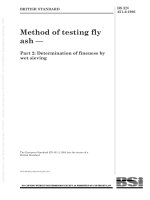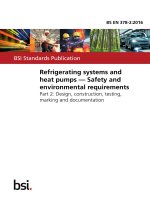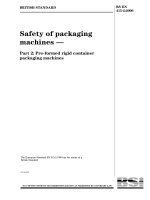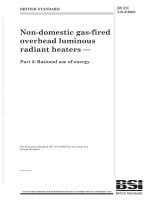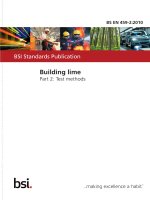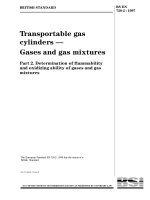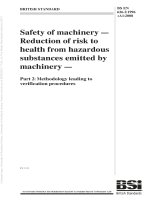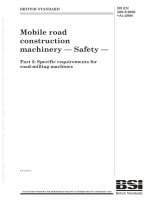Bsi bs en 60068 2 78 2013
Bạn đang xem bản rút gọn của tài liệu. Xem và tải ngay bản đầy đủ của tài liệu tại đây (1.03 MB, 14 trang )
BS EN 60068-2-78:2013
BSI Standards Publication
Environmental testing
Part 2-78: Tests — Test Cab: Damp
heat, steady state
BRITISH STANDARD
BS EN 60068-2-78:2013
National foreword
This British Standard is the UK implementation of EN 60068-2-78:2013. It is
identical to IEC 60068-2-78:2012. It supersedes BS EN 60068-2-78:2002,
which will be withdrawn on 3 December 2015.
The UK participation in its preparation was entrusted to Technical Committee
GEL/104, Environmental conditions, classification and testing.
A list of organizations represented on this committee can be obtained on
request to its secretary.
This publication does not purport to include all the necessary provisions of a
contract. Users are responsible for its correct application.
© The British Standards Institution 2013.
Published by BSI Standards Limited 2013
ISBN 978 0 580 72152 6
ICS 19.040; 29.020
Compliance with a British Standard cannot confer immunity from
legal obligations.
This British Standard was published under the authority of the Standards
Policy and Strategy Committee on 31 July 2013.
Amendments/corrigenda issued since publication
Date
Text affected
BS EN 60068-2-78:2013
EN 60068-2-78
EUROPEAN STANDARD
NORME EUROPÉENNE
EUROPÄISCHE NORM
June 2013
ICS 19.040; 29.020
Supersedes EN 60068-2-78:2001
English version
Environmental testing Part 2-78: Tests Test Cab: Damp heat, steady state
(IEC 60068-2-78:2012)
Essais d'environnement Partie 2-78: Essais Essai Cab: Chaleur humide, essai continu
(CEI 60068-2-78:2012)
Umgebungseinflüsse Teil 2-78: Prüfverfahren Prüfung Cab: Feuchte Wärme, konstant
(IEC 60068-2-78:2012)
This European Standard was approved by CENELEC on 2012-12-03. CENELEC members are bound to comply
with the CEN/CENELEC Internal Regulations which stipulate the conditions for giving this European Standard
the status of a national standard without any alteration.
Up-to-date lists and bibliographical references concerning such national standards may be obtained on
application to the CEN-CENELEC Management Centre or to any CENELEC member.
This European Standard exists in three official versions (English, French, German). A version in any other
language made by translation under the responsibility of a CENELEC member into its own language and notified
to the CEN-CENELEC Management Centre has the same status as the official versions.
CENELEC members are the national electrotechnical committees of Austria, Belgium, Bulgaria, Croatia, Cyprus,
the Czech Republic, Denmark, Estonia, Finland, Former Yugoslav Republic of Macedonia, France, Germany,
Greece, Hungary, Iceland, Ireland, Italy, Latvia, Lithuania, Luxembourg, Malta, the Netherlands, Norway, Poland,
Portugal, Romania, Slovakia, Slovenia, Spain, Sweden, Switzerland, Turkey and the United Kingdom.
CENELEC
European Committee for Electrotechnical Standardization
Comité Européen de Normalisation Electrotechnique
Europäisches Komitee für Elektrotechnische Normung
Management Centre: Avenue Marnix 17, B - 1000 Brussels
© 2013 CENELEC -
All rights of exploitation in any form and by any means reserved worldwide for CENELEC members.
Ref. No. EN 60068-2-78:2013 E
BS EN 60068-2-78:2013
EN 60068-2-78:2013
-2-
Foreword
The text of document 104/582/FDIS, future edition 2 of IEC 60068-2-78, prepared by IEC/TC 104
"Environmental conditions, classification, and methods of test" was submitted to the IEC-CENELEC
parallel vote and approved by CENELEC as EN 60068-2-78:2013.
The following dates are fixed:
•
latest date by which the document has
to be implemented at national level by
publication of an identical national
standard or by endorsement
(dop)
2013-12-14
•
latest date by which the national
standards conflicting with the
document have to be withdrawn
(dow)
2015-12-03
This document supersedes EN 60068-2-78:2001.
EN 60068-2-78:2013 includes
EN 60068-2-78:2001:
the
following
significant
technical
changes
with
respect
to
The test chamber from EN 60068-3-6 has been introduced.
Attention is drawn to the possibility that some of the elements of this document may be the subject of
patent rights. CENELEC [and/or CEN] shall not be held responsible for identifying any or all such
patent rights.
Endorsement notice
The text of the International Standard IEC 60068-2-78:2012 was approved by CENELEC as a
European Standard without any modification.
BS EN 60068-2-78:2013
EN 60068-2-78:2013
-3-
Annex ZA
(normative)
Normative references to international publications
with their corresponding European publications
The following documents, in whole or in part, are normatively referenced in this document and are
indispensable for its application. For dated references, only the edition cited applies. For undated
references, the latest edition of the referenced document (including any amendments) applies.
NOTE When an international publication has been modified by common modifications, indicated by (mod), the relevant EN/HD
applies.
Publication
Year
Title
EN/HD
Year
IEC 60068-1
-
Environmental testing Part 1: General and guidance
EN 60068-1
-
IEC 60068-3-6
-
Environmental testing EN 60068-3-6
Part 3-6: Supporting documentation and
guidance - Confirmation of the performance
of temperature/humidity chambers
-
IEC Guide 104
-
The preparation of safety publications and
the use of basic safety publications and
group safety publications
-
-
–2–
BS EN 60068-2-78:2013
60068-2-78 IEC:2012
CONTENTS
INTRODUCTION ..................................................................................................................... 5
1
Scope and object .............................................................................................................. 6
2
Normative references ....................................................................................................... 6
3
Terms and definitions ....................................................................................................... 6
4
General test procedure ..................................................................................................... 6
5
4.1 Test chamber and measuring system ...................................................................... 6
4.2 Severity ................................................................................................................... 7
4.3 Pre-conditioning ...................................................................................................... 7
4.4 Testing procedure ................................................................................................... 7
4.5 Recovery procedure ................................................................................................ 8
Measurements .................................................................................................................. 8
6
5.1 Initial measurements ............................................................................................... 8
5.2 Intermediate measurements .................................................................................... 8
5.3 Final measurements ................................................................................................ 8
Information to be given in the relevant specification.......................................................... 8
7
Information to be given in the test report .......................................................................... 9
Table 1 – Temperature and relative humidity .......................................................................... 7
BS EN 60068-2-78:2013
60068-2-78 IEC:2012
–5–
INTRODUCTION
This part of IEC 60068 provides a test method of high humidity at constant temperature
without condensation on the specimen over a prescribed period. This test is performed to
evaluate the specimen as it is influenced by the absorption and diffusion of moisture and
moisture vapour.
–6–
BS EN 60068-2-78:2013
60068-2-78 IEC:2012
ENVIRONMENTAL TESTING –
Part 2-78: Tests – Test Cab: Damp heat, steady state
1
Scope and object
This part of IEC 60068 establishes a test method for determining the ability of components or
equipment to withstand transportation, storage and use under conditions of high humidity.
The object of this standard is to investigate the effect of high humidity at constant temperature
without condensation on a specimen over a prescribed period.
It is applicable to small equipment or components as well as large equipment, and can be
applied to both heat-dissipating and non-heat-dissipating specimens.
2
Normative references
The following documents, in whole or in part, are normatively referenced in this document and
are indispensable for its application. For dated references, only the edition cited applies. For
undated references, the latest edition of the referenced document (including any
amendments) applies.
IEC 60068-1, Environmental testing – Part 1:General and guidance
IEC 60068-3-6, Environmental testing – Part 3-6: Supporting documentation and guidance –
Confirmation of the performance of temperature and humidity chambers
IEC Guide 104, The preparation of safety publications and the use of basic safety publications
and group safety publications
3
Terms and definitions
None.
4
4.1
General test procedure
Test chamber and measuring system
The temperature and humidity chamber shall be constructed and verified in accordance with
specifications IEC 60068-3-6.
The chamber and measuring system shall be such that
–
sensing devices can be located in the working space to monitor the temperature and
humidity,
NOTE For heat-dissipating specimens, the temperature and humidity near the specimen may be influenced by
the effect of heat dissipation from the specimen.
–
condensed water is drained from the chamber and not re-used unless purified,
–
no condensed water from the walls and roof of the test chamber can fall on the
specimen(s),
BS EN 60068-2-78:2013
60068-2-78 IEC:2012
–7–
–
water utilized to maintain humidity levels has electrical conductivity of not more than
20 µS/cm,
–
the specimen under test shall not be subjected to radiant heat from the chamber
conditioning devices,
–
injected moisture, when applicable, is injected remotely from the specimen and without
being directly on it,
–
the volume of the test chamber is at least five times the total volume of the specimen
under test,
–
a mounting device, when used, has minimum influence on the heat and humidity
exchanges between specimen and surrounding conditions, unless otherwise specified in
the relevant specification.
4.2
Severity
The test severity is defined by a combination of temperature, relative humidity (RH) and total
test duration. Unless otherwise specified in the relevant specification, temperature and RH
severities may be selected from the following:
Table 1 – Temperature and relative humidity
Temperature
°C
Relative humidity
% RH
30 ± 2
93 ± 3
30 ± 2
85 ± 3
40 ± 2
93 ± 3
40 ± 2
85 ± 3
Preferred test durations are: 12 h, 16 h, 24 h; 2 days, 4 days, 10 days, 21 days or 56 days.
The total temperature tolerance of ± 2 K is intended to take account of absolute errors in the
measurement, slow changes of temperature and temperature variations of the working space.
However, in order to maintain the RH within the required tolerances, it is necessary to keep
the temperature difference between any two points in the working space at any moment within
narrower limits. The required humidity conditions will not be achieved if such temperature
differences exceed 1 K. It may also be necessary to keep short-term fluctuations within
± 0,5 K to maintain the required humidity.
4.3
Pre-conditioning
The relevant specification may call for pre-conditioning.
4.4
Testing procedure
The specimen shall be introduced into the chamber as required by the relevant specification.
The specimen shall be introduced in the unpacked, switched-off, ready-for-use state, or as
otherwise specified in the relevant specification.
In certain cases the relevant specification may allow the introduction of the specimen in the
chamber when this is already in the condition prescribed for the test; however, condensation
on the specimen shall always be avoided. This can be obtained for small specimens by preheating them to the chamber temperature.
Adjust the temperature in the chamber to the prescribed severity. In order to avoid
condensation on the specimen, control the specimen temperature or allow the specimen to
reach the temperature first and then adjust the humidity in the chamber to the prescribed
severity.
–8–
BS EN 60068-2-78:2013
60068-2-78 IEC:2012
Adjust the humidity to the prescribed severity within a period of time of not more than 2 h.
Expose the specimen to the test conditions and duration as specified in the relevant
specification. The duration is measured from the time the specified conditions are achieved.
The relevant specification shall define the operating conditions and the period (or periods) in
which they shall be carried out.
After conditioning at the prescribed severity and before the final measurement, the recovery
procedure shall be followed.
4.5
Recovery procedure
The relevant specification shall prescribe the recovery method and duration.
conditions are described in IEC 60068-1.
5
Recovery
Measurements
5.1
Initial measurements
The specimen shall be visually inspected and electrically and mechanically checked, as
required by the relevant specification.
5.2
Intermediate measurements
The relevant specification may call for measurements during the test procedure while the
specimen is still in the chamber. If such measurements are required, the relevant specification
shall define the measurements and the period (periods) at which they shall be carried out. For
these measurements, the specimen shall not be removed from the chamber.
5.3
Final measurements
The specimen shall be visually inspected and electrically and mechanically checked, as
required by the relevant specification.
6
Information to be given in the relevant specification
The following details shall be given as far as they are applicable:
a) preconditioning;
b) initial measurements;
c) details of mounting or supports;
d) state of specimen (unpowered, powered, packaged, unpackaged, etc.);
e) type of specimen – heat dissipating or non-heat dissipating;
f)
test severities and tolerances
1)
temperature,
2)
relative humidity,
3)
duration;
g) intermediate measurements;
h) recovery conditions;
i)
final measurements;
j)
any deviation in procedure as agreed upon between customer and supplier.
BS EN 60068-2-78:2013
60068-2-78 IEC:2012
7
–9–
Information to be given in the test report
As a minimum, the test report shall contain the following information. Items shown in
parentheses are examples.
a)
Customer
(name and address)
b)
Test laboratory
(name and address and details of
accreditation – if any)
c)
Test dates
(dates when test was run)
d)
Type of test
(Cab)
e)
Purpose of test
(development, qualification, etc.)
f)
Test standard, edition
(IEC 60068-2-78:edition used)
g)
Relevant laboratory test procedure
(code and object)
h)
Test specimen description
(drawing, photo, quantity, build status, etc.).
i)
Test chamber identity
(manufacturer, model number, unique
identification, etc.)
j)
Performance of test apparatus
(set point temperature control, air flow, etc.)
k)
Uncertainties of measuring system
(uncertainties data)
l)
Calibration data
(last and next due date)
m)
Initial, intermediate and final
measurements
(initial, intermediate and final
measurements)
n)
Required severities
(from relevant specification)
o)
Actual test conditions
(measurement location, data, etc.)
p)
Performance of test specimens
(results of functional tests, etc.)
q)
Observations during testing and
actions taken
(any pertinent observations)
r)
Summary of test
(test summary)
s)
Distribution
(distribution list)
_____________
This page deliberately left blank
This page deliberately left blank
NO COPYING WITHOUT BSI PERMISSION EXCEPT AS PERMITTED BY COPYRIGHT LAW
British Standards Institution (BSI)
BSI is the national body responsible for preparing British Standards and other
standards-related publications, information and services.
BSI is incorporated by Royal Charter. British Standards and other standardization
products are published by BSI Standards Limited.
About us
Revisions
We bring together business, industry, government, consumers, innovators
and others to shape their combined experience and expertise into standards
-based solutions.
Our British Standards and other publications are updated by amendment or revision.
The knowledge embodied in our standards has been carefully assembled in
a dependable format and refined through our open consultation process.
Organizations of all sizes and across all sectors choose standards to help
them achieve their goals.
Information on standards
We can provide you with the knowledge that your organization needs
to succeed. Find out more about British Standards by visiting our website at
bsigroup.com/standards or contacting our Customer Services team or
Knowledge Centre.
Buying standards
You can buy and download PDF versions of BSI publications, including British
and adopted European and international standards, through our website at
bsigroup.com/shop, where hard copies can also be purchased.
If you need international and foreign standards from other Standards Development
Organizations, hard copies can be ordered from our Customer Services team.
Subscriptions
Our range of subscription services are designed to make using standards
easier for you. For further information on our subscription products go to
bsigroup.com/subscriptions.
With British Standards Online (BSOL) you’ll have instant access to over 55,000
British and adopted European and international standards from your desktop.
It’s available 24/7 and is refreshed daily so you’ll always be up to date.
You can keep in touch with standards developments and receive substantial
discounts on the purchase price of standards, both in single copy and subscription
format, by becoming a BSI Subscribing Member.
PLUS is an updating service exclusive to BSI Subscribing Members. You will
automatically receive the latest hard copy of your standards when they’re
revised or replaced.
To find out more about becoming a BSI Subscribing Member and the benefits
of membership, please visit bsigroup.com/shop.
With a Multi-User Network Licence (MUNL) you are able to host standards
publications on your intranet. Licences can cover as few or as many users as you
wish. With updates supplied as soon as they’re available, you can be sure your
documentation is current. For further information, email
BSI Group Headquarters
389 Chiswick High Road London W4 4AL UK
We continually improve the quality of our products and services to benefit your
business. If you find an inaccuracy or ambiguity within a British Standard or other
BSI publication please inform the Knowledge Centre.
Copyright
All the data, software and documentation set out in all British Standards and
other BSI publications are the property of and copyrighted by BSI, or some person
or entity that owns copyright in the information used (such as the international
standardization bodies) and has formally licensed such information to BSI for
commercial publication and use. Except as permitted under the Copyright, Designs
and Patents Act 1988 no extract may be reproduced, stored in a retrieval system
or transmitted in any form or by any means – electronic, photocopying, recording
or otherwise – without prior written permission from BSI. Details and advice can
be obtained from the Copyright & Licensing Department.
Useful Contacts:
Customer Services
Tel: +44 845 086 9001
Email (orders):
Email (enquiries):
Subscriptions
Tel: +44 845 086 9001
Email:
Knowledge Centre
Tel: +44 20 8996 7004
Email:
Copyright & Licensing
Tel: +44 20 8996 7070
Email:

